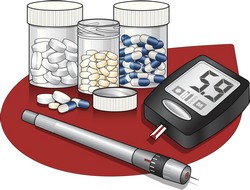A novel therapeutic angle on diabetes
T2D is a complex multisystem disease that initiates with insulin resistance and suppression of glucose disposal by the liver and peripheral tissues. This ultimately leads to insufficient insulin secretion by the pancreatic β-cells, thus raising blood glucose levels. Although emerging evidence unveils a genetic predisposition to T2D, the Western lifestyle, which is characterised by excessive nutrient intake and lack of exercise, is regarded as the leading cause. Binding of PPARγ, a master regulator of adipogenesis, to a nuclear hormone receptor is central to T2D initiation and development. Thiazolidinedione (TZD) are insulin sensitisers that target PPARγ, which are currently available as oral anti-diabetic drugs. Unfortunately, TZDs are associated with undesirable side effects and better alternatives are needed for T2D treatment. In a previous study, scientists on the EU-funded FGF1T2D (FGF1: a novel metabolic regulator involved in insulin sensitization and glycemic control) project had discovered that administration of fibroblast growth factor 1 (FGF1) to diabetic mice mimicked the metabolic effects of TZDs. During FGF1T2D, researchers explained this observation by providing evidence for a novel PPARγ-FGF1 endocrine signalling pathway that regulates the adaptive response to a high-fat diet. Project results underscored a role for FGF1 as a critical regulator of adipose tissue remodelling, with mice lacking FGF1 developing an aggressive diabetic phenotype. Parenteral delivery of recombinant FGF1 lowered glucose levels in diabetic mice in an insulin-dependent manner, suggesting that it could be used for the treatment of insulin resistance and T2D. Interestingly, this attribute of FGF1 was separate from its mitogenic activity. Furthermore, FGF1 stimulated hepatic lipid catabolism, thereby reducing liver steatosis and inflammation in mouse models of non-alcoholic fatty liver disease. Overall, the FGF1T2D project discovered FGF1 as a novel target of PPARγ and a hormone capable of improving glycaemia and insulin resistance. Its potential therapeutic use against T2D extends its current clinical applications beyond wound and fracture healing and treatment of cardiovascular diseases.







